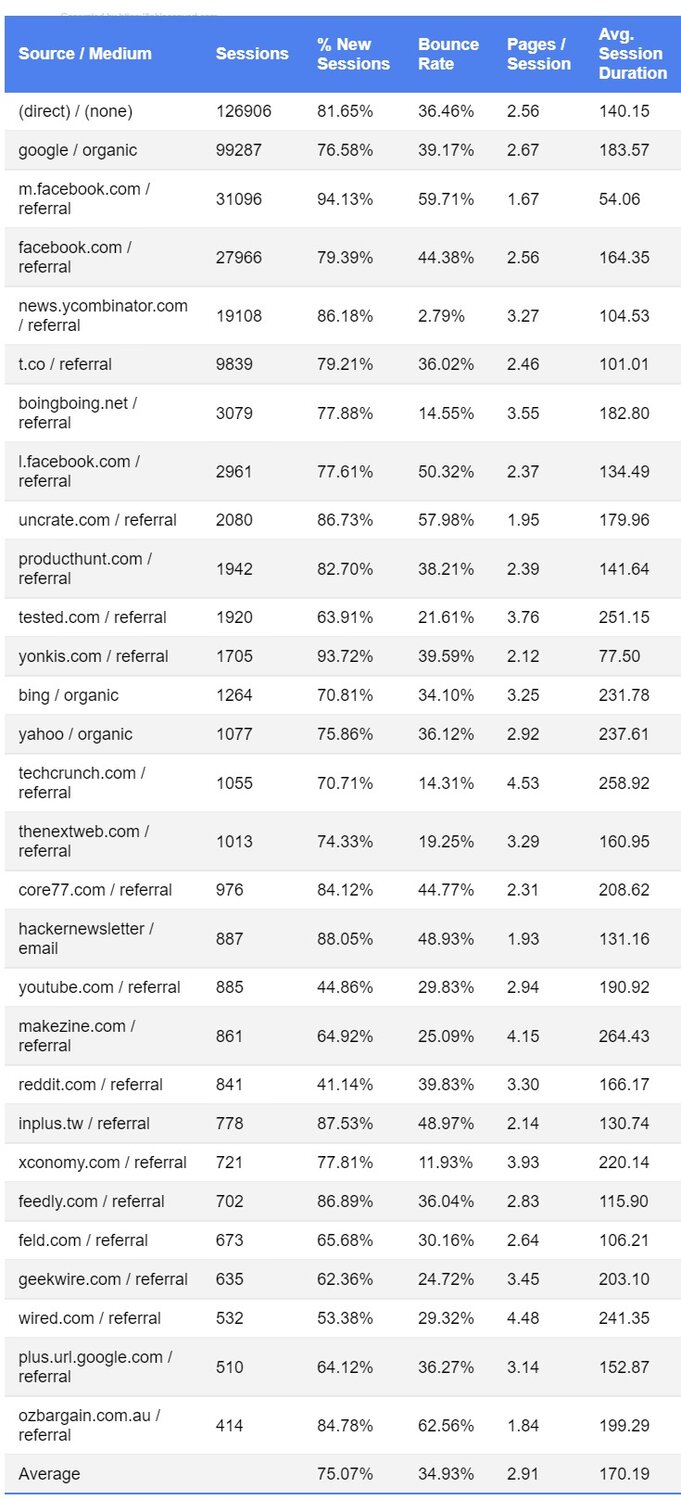Anatomy of a 5 Million Dollar Week
September 30, 2015
Dan ShapiroIt’s been a wild ride in the last seven days – since we launched Glowforge at Makerfaire, we’ve had more than $5M in pre-orders. To put that in perspective, the most-backed 3D printer in history (as best we can tell) raised $3.5M, and that took 30 days. If we were a Kickstarter, we’d be nipping at Levar Burton’s heels. And we still have three more to go.
I love numbers, and I’m somewhat embarrassed that, in all the fuss, we didn’t properly instrument conversion tracking on glowforge.com. We know visitors, but not buyers. My bad. I’m going to share as much as I’ve got, regardless.
I’ll start with the stat that blew me away the most: top referrers. Here’s the raw data, courtesy Google Analytics.

Now: knock me over with a feather. After direct and facebook, the number one referrer – by a huge margin – was Hacker News (news.ycombinator.com). Not only did it deliver the numbers, but when compared to the averages, it killed in pages/session and bounce rate. I’m actually a little puzzled by the bounce rate one – how could 97% of people have not bounced? It boggles the mind. Something’s odd there.
I did miss something interesting there though: mobile facebook beat desktop. I don’t have an explanation for that at all; most of our traffic is desktop, so that doesn’t make sense. Another mystery. But it’s a good thing the site design is responsive.
In any case, twitter was next, then boingboing. Uncrate, producthunt, tested.com did an epic 22 minute hands on video so those all make sense. Then… Yonkis? I’ll save you an oops-click: Yonkis is quite NSFW, and entirely in Spanish. I’m just not sure what we’re doing there. Maybe someone who speaks Spanish (and isn’t at work) can tell me.
It’s cute to see Bing and Yahoo waving from the back of the bus. I was surprised Techcrunch punched so low. Makezine.com sent us some really engaged traffic (4.15 pages average, and look at the huge time on site!) and there were some solid contributions from articles in xconomy, geekwire, an old Wired article, and of course our board member Brad Feld. It’s good to have a board member who can drive $60k in revenue overnight with a blog post.
Moving on to actual orders, we had some internal bets about what % of total orders would come from overseas. At first I thought I was going down – I guessed 20%, but it was coming in at 10%. We knew it was going to be low because it’s stupidly expensive to ship a 46″ x 29″ x 16″ box halfway around the world. I’ve investigated cheaper international shipping options before, but the time it would have taken to make this happen would have just come out of the logistics work that we needed to do to ship to the rest of our customers in a timely fashion.
But here’s the funny thing: the international percentages crept up, and are now nearly 20%. I think I know why. But to explain, I have to jump over to another set of analytics: customer support.
We’ve had 4,000 trouble tickets pour in since we launched. And that’s not counting the questions on Twitter, comment threads on articles, and the conversation on our own Discourse-powered board (for backers only) at community.glowforge.com. As soon as we went live, we convened a war room in our hotel, and the entire company shuttled between booth duty doing demos (like this) and answering tickets. Our backlog exploded as thousands of tickets went unanswered.
We’ve got things under control now and are clearing out the last 800 or so backlogged tickets, but what we found was that international customers had a disproportionate number of questions. As we answered them, they started buying. That was unexpected, but cool – we unlocked a ton of revenue by ceasing to suck at support.
Finally, the sales breakdown. We got a lot of stuff wrong, but this was probably the biggest. We offer three models: basic, basic with air filter, and pro with air filter. Everything seen on our site can be made with the basic, and it’s priced at about a fifth of the most popular lasers from companies like Epilog and Trotec. We figured people were going to flood to it, then maybe upgrade to the air filter. The air filter is another steal because similar hardware goes for $2,500, but it’s just $500 additional. But our favorite offering was the Pro model. We almost didn’t make it available – paradox of choice and all – and we thought people might not want it. It’s meaningfully more expensive at $3,995. But it’s the one all of us are getting. It’s faster (upgraded optics and tube). It can run all day (upgraded cooling). And it has a passthrough, coupled with software to optically track the material as it goes through – so you can cut material that’s 20″ x 8 feet long. Laser furniture!
The Pro has a big drawback though: while the Basic is a Class 1 laser device (like a blu-ray player), the passthrough makes the Pro a Class IV device. It requires safety precautions like warning signs and safety goggles. Anyway, our rough guess was something like 50% basic, 40% basic + air, 10% pro.
Knock me over with a feather: the mix turned out to be 23% basic, 29% basic + air, 48% pro. Everyone wants the Glowforge Pro. Which is awesome, because we know Pro users are going to have the best possible Glowforge experience, and we really want as many people as possible to have that. (Safely though! Make sure you don’t have little ones around if you’re buying the Pro, and read up on laser safety).
That’s what we’ve got for data so far – hope it proves interesting!
You don't want to miss